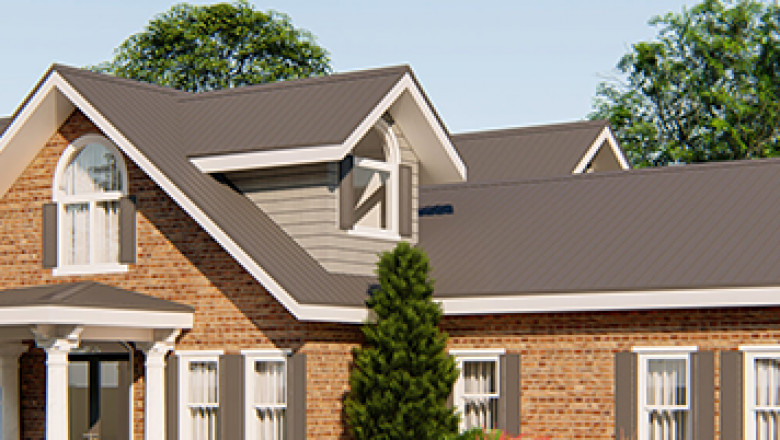views
The growing awareness of environmental challenges has inspired a global shift toward sustainable living. At the heart of this movement is the concept of eco sustainable home designs—housing solutions that harmonize with nature while reducing environmental impact. These homes are not only functional but also innovative, offering a glimpse into the future of sustainable living. Let's explore some cutting-edge ideas that are reshaping the way we think about eco-friendly architecture.
1. Embracing Renewable Energy Sources
One of the cornerstones of eco sustainable home designs is the integration of renewable energy sources. Solar panels, for instance, have become a popular choice for homeowners looking to harness the power of the sun. Modern solar systems are more efficient than ever and can significantly reduce electricity bills while minimizing the home's carbon footprint.
Another emerging trend is the use of wind energy in residential settings. Small wind turbines, designed for urban or suburban environments, are helping homeowners generate clean energy. Coupled with energy storage solutions such as batteries, these renewable systems ensure a consistent energy supply, even during less favorable weather conditions.
2. Sustainable Building Materials
The materials used in construction play a crucial role in determining a home's environmental impact. Eco sustainable home designs prioritize materials that are renewable, recycled, or locally sourced. Examples include bamboo, reclaimed wood, and recycled metal.
Innovative materials like hempcrete—a mixture of hemp, lime, and water—are gaining traction for their durability and insulation properties. Hempcrete is not only sustainable but also contributes to improved indoor air quality. Similarly, green concrete, made from recycled materials, reduces the reliance on traditional cement, a major contributor to CO2 emissions.
3. Passive Design Principles
Passive design is an architectural approach that maximizes natural resources to regulate a home’s temperature. By strategically positioning windows and using materials that store and release heat, passive design minimizes the need for artificial heating and cooling.
For instance, eco sustainable homes often include features like large, south-facing windows to capture sunlight during winter. Shading devices or overhangs are used to block excessive heat during summer, ensuring comfortable indoor temperatures year-round. Proper insulation and airtight construction further enhance energy efficiency, reducing reliance on HVAC systems.
4. Green Roofing and Living Walls
Green roofs, also known as living roofs, are a striking feature of modern eco sustainable homes. These roofs are covered with vegetation, providing natural insulation and reducing the urban heat island effect. They also improve air quality, manage stormwater runoff, and create habitats for wildlife.
Living walls, or vertical gardens, are another innovative feature. These walls are adorned with plants that purify the air, regulate indoor temperatures, and add aesthetic appeal. In addition to their environmental benefits, green roofs and living walls contribute to a sense of tranquility and connection with nature.
5. Water Conservation Innovations
Water scarcity is a pressing issue in many parts of the world, and eco sustainable home designs incorporate strategies to address this challenge. Rainwater harvesting systems collect and store rainwater for use in irrigation, flushing toilets, or even drinking (with proper filtration).
Greywater recycling systems are also becoming increasingly popular. These systems treat and reuse water from sinks, showers, and washing machines for non-potable purposes. Low-flow fixtures, such as faucets and toilets, further reduce water consumption without compromising functionality.
6. Smart Home Technology for Sustainability
The integration of smart home technology has revolutionized eco sustainable home designs. Smart thermostats, for example, learn a household's temperature preferences and adjust settings to optimize energy efficiency. Smart lighting systems, equipped with motion sensors, ensure that lights are only used when needed.
Advanced home automation systems allow residents to monitor and control energy use remotely. By providing real-time data on energy consumption, these technologies empower homeowners to make informed decisions and reduce waste.
7. Biophilic Design: Bringing Nature Indoors
Biophilic design is an innovative approach that emphasizes the connection between humans and nature. Eco sustainable homes incorporate elements like natural light, indoor plants, and materials that mimic natural textures. These features not only enhance the aesthetic appeal of the home but also promote well-being and reduce stress.
Open floor plans that blur the boundaries between indoor and outdoor spaces are another hallmark of biophilic design. Features like sliding glass doors, indoor courtyards, and large windows create a seamless transition between the home and its natural surroundings.
8. Modular and Prefabricated Construction
Modular and prefabricated homes are transforming the construction industry with their eco-friendly advantages. These homes are built in controlled factory environments, reducing waste and energy consumption. Prefabrication also allows for faster construction times and ensures consistent quality.
Many modular homes are designed to be easily customizable and adaptable, making them a flexible option for sustainable living. These homes often incorporate renewable energy systems and sustainable materials, further enhancing their eco credentials.
Conclusion
Eco sustainable home designs represent a bold and necessary step toward building a greener future. By combining innovative technologies with environmentally friendly practices, these homes prove that sustainability and style can go hand in hand. Whether it's through renewable energy, sustainable materials, or biophilic design, the possibilities for creating eco-friendly homes are endless. Embracing these ideas not only benefits the planet but also enhances the quality of life for those who call these spaces home. Together, we can build a world where sustainability is at the heart of every design decision.















![What Is The QuickBooks Enterprise Support Number [[GET Quick Assistance]]](https://timessquarereporter.com/public/upload/media/posts/2025-06/04/what-is-the-quickbooks-enterprise-support-number-get-quick-assistance_1749095947-s.jpg)






Comments
0 comment